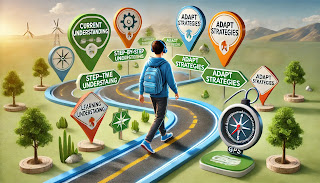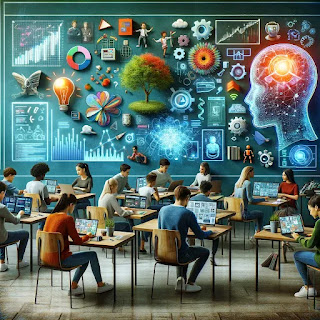The Importance of Reflection and Reflective Practice in Higher Education
I created the image by DALL.E
In the ever-evolving landscape of
higher education, where innovation and deadlines often take centre stage, reflection
and reflective practice are vital tools for educators and students. They
help us navigate complexity, foster personal and professional growth, and
ensure that we continuously adapt to meet the needs of an increasingly dynamic
academic world.
Reflective practice goes far
beyond a cursory glance at past events. It involves critically analysing
experiences to draw meaningful insights that inform future decisions.
Whether you are an educator striving to inspire students, a researcher working
on groundbreaking projects, or a student navigating academic challenges,
reflection is a cornerstone for growth and excellence.
This blog post explores the
significance of reflective practice in higher education, its benefits, and
practical ways to incorporate it into our daily routines.
What Is Reflective Practice?
Reflective practice involves
examining one’s experiences, identifying successes and shortcomings, and using
these insights to inform future actions. Originating from the work of scholars
like Donald Schön and David Kolb, reflective practice has been widely embraced
across disciplines like Education, Nursing, Engineering, and the Arts.
It is not just about looking
back; it’s about making sense of what happened and translating those insights
into actionable improvements. In higher education, reflective practice
benefits educators and students, enhancing teaching effectiveness, learning
outcomes, and personal development.
Benefits of Reflection in
Higher Education
1. Bridging the Gap Between
Theory and Practice
One of the biggest challenges for
many disciplines, particularly professional fields like Nursing, Engineering,
and Education, is applying theoretical knowledge to real-world scenarios.
Reflective practice helps students connect abstract concepts to practical
applications. For educators, reflection ensures that teaching methods align
with real-world demands, preparing students to excel in their chosen fields.
For example, a Nursing student
might reflect on a clinical placement experience to better understand how
theoretical frameworks apply in patient care. Similarly, educators can evaluate
whether their teaching strategies enable students to make these critical
connections effectively.
2. Promoting Lifelong Learning
and Adaptability
In a world shaped by rapid
technological advances, particularly Generative AI and digital
transformation, the ability to learn, unlearn, and relearn is indispensable. The
reflective practice cultivates this mindset by encouraging individuals to
identify gaps in their knowledge and skills, embrace feedback, and strive for
continuous improvement.
Students who engage in reflective
activities develop metacognitive skills, enabling them to evaluate their
learning strategies and make adjustments. Educators who reflect on their
teaching approaches can identify opportunities to integrate emerging
technologies or pedagogical innovations into their practice.
3. Building Resilience and
Emotional Intelligence
Reflective practice provides a
structured way to process challenges, failures, and successes. This helps build
emotional intelligence and resilience, which are increasingly valued in
the workforce and academia.
For example, students who reflect
on academic setbacks, such as disappointing grades, can identify specific areas
for improvement, develop coping strategies, and build the confidence to tackle
future challenges. Similarly, educators can reflect on difficult classroom
situations to better understand their emotional responses and improve their
interpersonal skills.
4. Aligning with Institutional
Goals
Universities increasingly
prioritise sustainability, equity, and innovation as strategic goals.
Reflective practice ensures that individual actions align with these broader
objectives. For instance, educators can reflect on whether their teaching
methods promote inclusivity and sustainability or explore how to integrate the
United Nations Sustainable Development Goals (SDGs) into their curriculum.
Incorporating Reflective Practice into Higher Education
For Educators:
Ø
Reflect on Teaching
Practices: After each class, take a few minutes to ask yourself:
Ø
What worked well?
Ø
What could I improve?
Ø
How did students respond,
and what does that tell me about their needs?
Ø
Use Reflective Journals:
Maintain a journal documenting experiences, challenges, and lessons learned
from teaching. Over time, this can become a valuable resource for personal and
professional development.
Ø
Engage in Peer
Reflection: Collaborate with colleagues to share experiences and insights.
Peer feedback can provide fresh perspectives and help refine teaching
strategies.
Ø
Incorporate Reflective
Assignments: Encourage students to reflect on their learning experiences
through journals, portfolios, or presentations. This enhances their learning
and fosters a culture of reflection within your institution.
For Students:
Ø
Practice Self-Reflection:
At the end of each week, reflect on your learning experiences. Consider
questions like:
Ø
What new concepts did I
learn, and how do they connect to what I already know?
Ø
What challenges did I face,
and how did I overcome them?
Ø
Engage in Group
Reflection: Discuss with peers to share insights and learn from different
perspectives. This is particularly valuable in collaborative projects or
placements.
Ø
Use Reflective
Frameworks: Adopt models like Gibbs’ Reflective Cycle or Kolb’s
Experiential Learning Cycle to structure your reflections and ensure they lead
to actionable outcomes.
Ø
Leverage Technology:
Use tools like digital journals or e-portfolios to document and share
reflections. Some universities integrate reflective platforms into their
learning management systems to make this process seamless.
Reflection in Action: A Personal Perspective
The photograph accompanying this
blog post on my university campus is a powerful metaphor for the reflective
process. The still water reflects its surroundings, offering a moment of
clarity and perspective. Similarly, reflective practice allows us to pause,
evaluate our journey, and chart an improvement course.
Reflection has been
transformative in my practice as an educator. By revisiting my teaching
methods, I’ve identified ways to make lessons more engaging and aligned with
student needs. Reflecting on challenges has taught me resilience and
adaptability, while celebrating successes has fuelled my passion for teaching
and learning.
A Call to Action
Reflection is not a luxury; it is
a necessity in the pursuit of excellence. Whether you are a student,
educator, or researcher, pause and reflect on your experiences. Use those
insights to refine your strategies, embrace change, and create a meaningful
impact on your academic and professional journey.
Let’s foster a culture of
reflective practice in higher education. Together, we can shape a learning
environment that values thoughtful innovation, lifelong learning, and personal
growth.
Your Turn: Share Your Reflections
I’d love to hear how you
incorporate reflection into your work or studies. What tools, frameworks, or
strategies have worked for you? Let’s inspire one another to embrace the power
of reflection.
#HigherEducation #Reflection #TeachingInnovation
#LifelongLearning #PersonalGrowth #Sustainability











